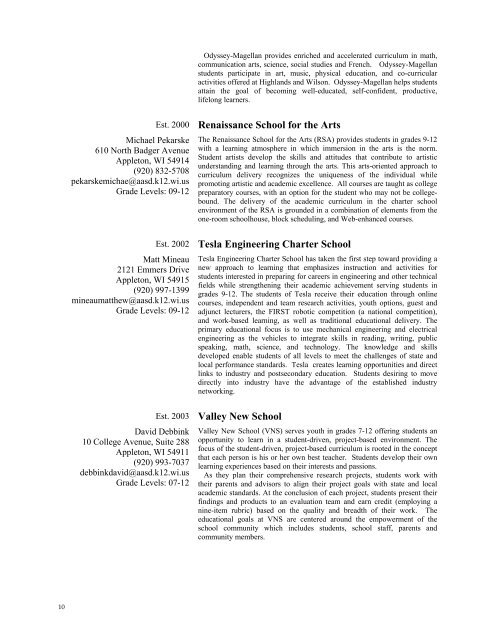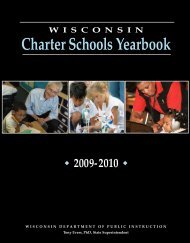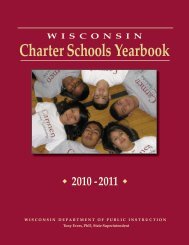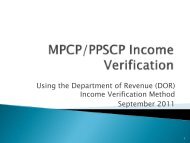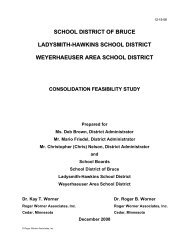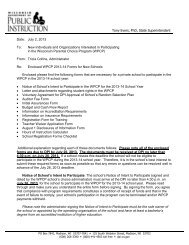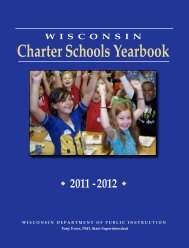Wisconsin Charter Schools Yearbook - School Management Services
Wisconsin Charter Schools Yearbook - School Management Services
Wisconsin Charter Schools Yearbook - School Management Services
You also want an ePaper? Increase the reach of your titles
YUMPU automatically turns print PDFs into web optimized ePapers that Google loves.
10<br />
Michael Pekarske<br />
610 North Badger Avenue<br />
Appleton, WI 54914<br />
(920) 832-5708<br />
pekarskemichae@aasd.k12.wi.us<br />
Grade Levels: 09-12<br />
Matt Mineau<br />
2121 Emmers Drive<br />
Appleton, WI 54915<br />
(920) 997-1399<br />
mineaumatthew@aasd.k12.wi.us<br />
Grade Levels: 09-12<br />
David Debbink<br />
10 College Avenue, Suite 288<br />
Appleton, WI 54911<br />
(920) 993-7037<br />
debbinkdavid@aasd.k12.wi.us<br />
Grade Levels: 07-12<br />
Odyssey-Magellan provides enriched and accelerated curriculum in math,<br />
communication arts, science, social studies and French. Odyssey-Magellan<br />
students participate in art, music, physical education, and co-curricular<br />
activities offered at Highlands and Wilson. Odyssey-Magellan helps students<br />
attain the goal of becoming well-educated, self-confident, productive,<br />
lifelong learners.<br />
Est. 2000 Renaissance <strong>School</strong> for the Arts<br />
The Renaissance <strong>School</strong> for the Arts (RSA) provides students in grades 9-12<br />
with a learning atmosphere in which immersion in the arts is the norm.<br />
Student artists develop the skills and attitudes that contribute to artistic<br />
understanding and learning through the arts. This arts-oriented approach to<br />
curriculum delivery recognizes the uniqueness of the individual while<br />
promoting artistic and academic excellence. All courses are taught as college<br />
preparatory courses, with an option for the student who may not be collegebound.<br />
The delivery of the academic curriculum in the charter school<br />
environment of the RSA is grounded in a combination of elements from the<br />
one-room schoolhouse, block scheduling, and Web-enhanced courses.<br />
Est. 2002 Tesla Engineering <strong>Charter</strong> <strong>School</strong><br />
Tesla Engineering <strong>Charter</strong> <strong>School</strong> has taken the first step toward providing a<br />
new approach to learning that emphasizes instruction and activities for<br />
students interested in preparing for careers in engineering and other technical<br />
fields while strengthening their academic achievement serving students in<br />
grades 9-12. The students of Tesla receive their education through online<br />
courses, independent and team research activities, youth options, guest and<br />
adjunct lecturers, the FIRST robotic competition (a national competition),<br />
and work-based learning, as well as traditional educational delivery. The<br />
primary educational focus is to use mechanical engineering and electrical<br />
engineering as the vehicles to integrate skills in reading, writing, public<br />
speaking, math, science, and technology. The knowledge and skills<br />
developed enable students of all levels to meet the challenges of state and<br />
local performance standards. Tesla creates learning opportunities and direct<br />
links to industry and postsecondary education. Students desiring to move<br />
directly into industry have the advantage of the established industry<br />
networking.<br />
Est. 2003 Valley New <strong>School</strong><br />
Valley New <strong>School</strong> (VNS) serves youth in grades 7-12 offering students an<br />
opportunity to learn in a student-driven, project-based environment. The<br />
focus of the student-driven, project-based curriculum is rooted in the concept<br />
that each person is his or her own best teacher. Students develop their own<br />
learning experiences based on their interests and passions.<br />
As they plan their comprehensive research projects, students work with<br />
their parents and advisors to align their project goals with state and local<br />
academic standards. At the conclusion of each project, students present their<br />
findings and products to an evaluation team and earn credit (employing a<br />
nine-item rubric) based on the quality and breadth of their work. The<br />
educational goals at VNS are centered around the empowerment of the<br />
school community which includes students, school staff, parents and<br />
community members.


